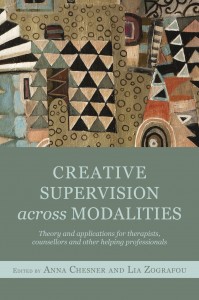 Anna Chesner, co-author of Creative Supervision Across Modalities, explains why using creativity in supervision sessions can benefit both the supervisor and supervisee, and gives her top tips for any therapist or helping professional new to using this approach.
Anna Chesner, co-author of Creative Supervision Across Modalities, explains why using creativity in supervision sessions can benefit both the supervisor and supervisee, and gives her top tips for any therapist or helping professional new to using this approach.
Why is the use of creativity so effective in supervision sessions?
Creativity helps to link right brain and left brain understanding of practice. Often as practitioners we may have a feeling of stuckness, or going round in circles. Using creative methods helps us to facilitate new perspectives and fresh energy.
How can creative supervision ensure that a fresh perspective is maintained in supervision sessions, and how does this benefit the supervisor and supervisee?
Creative supervision can bring a new perspective and fresh energy to reflecting on our clinical or other professional practice. This in term can bring fresh energy and clarity to our sessions with clients. If supervision itself lacks vitality it may become part of the problem, rather than facilitating possible solutions.
In chapters 2 and 3 of your new book you write about the importance of roles in creative supervision – why is this? Which of the roles you mention do you think it is most difficult for a new supervisor to take on? Is there one that they tend to slip into more easily?
Not so much roles as an understanding of role (singular). The concept of role helps us to think about our “way of being” and our clients’ way of being. It is a practical tool for looking at patterns of behaviour and relating. Supervisor’s need an awareness of the multiple roles they may inhabit as a supervisor, and in the best case some role flexibility. Similarly, practitioners from all fields can benefit from thinking about their own roles in their practice, and indeed the roles of their clients within their various systems.
What is the most challenging thing you have to cover with trainee supervisors? What is it that they usually struggle most with in terms of incorporating creativity into sessions?
Supervision trainees have firstly to meet the challenge of getting to grips with the role of supervisor, which is distinct from their more familiar roles as clinician. There is an added challenge in learning how to use creative techniques in a way that is a spontaneous response to the supervisory question or focus and remains firmly within the frame of supervision.
Why is it that ‘irrational’ thinking can be such a crucial part of the creative process?
Not so much irrational as out of awareness, or known only implicitly. Face to face clinical work involves the practitioner in complex, multi-layered interactions, where physical or felt sense, and imagination are as important as the actual words spoken. Our right brain awareness can be brought to light particularly well through creative approaches to supervision.
You mention several times the importance of establishing a clear focus in the supervisory session – why is this?
A clear focus or supervisory question is helpful for a number of reasons. It ensures transparency about what kind of help or reflection opportunity is being sought. It supports a collaborative approach between supervisor and supervisee. It reveals the level at which a supervisee is able to reflect on and articulate their process.
What are the top tips you would give to a supervisor who is new to using creativity in their sessions?
– Reflect on your own interventions in the light of supervision theory
– Bring your creative supervision practice to your own supervision space
– Remain open to new learning
– Undertake training in the use of creative supervision methods